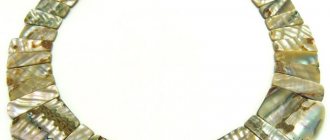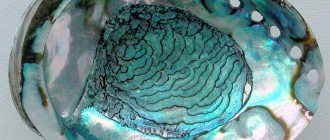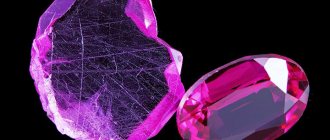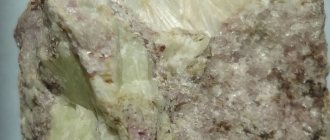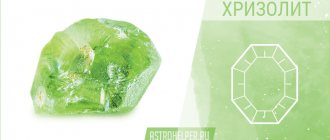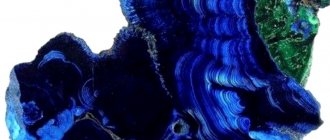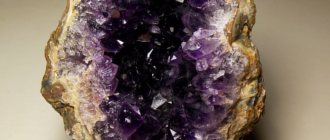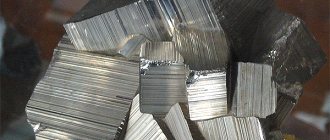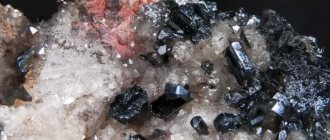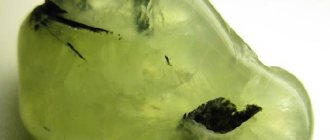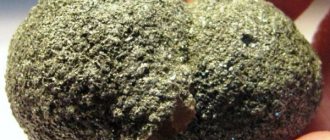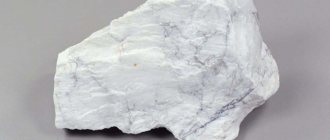- What: Ornamental;
- Deposits: South and North America, Africa, China, Kazakhstan, Russia (Crimea - Lake Sivash, Perm Territory - Kungur Cave);
- Colors: White, gray-green;
- Mohs hardness: 1-2;
- Transparency: Translucent;
- Density: 1.9-2 g/cm³;
- Formula: NaCa• 5 H2O;
- Suitable person according to zodiac sign: Everyone;
- How much does it cost: from 120 rubles.
Ulexite stone is a natural mineral found in warm climates. These are mainly small salt water bodies, salt marshes, and areas with arid climates. The English name of the mineral is Ulexite.
Origin story
Ulexite was first discovered in the first half of the 19th century in Chile.
Its relative “youth” is due to the fact that deposits of this mineral are rare.
However, due to the sedimentary method of formation, ulexite accumulations can be quite large, such as the South American saltpeter deposits containing boron ore.
The German chemist Georg Ludwig Ulex, who performed a reliable chemical analysis of the mineral, is considered its discoverer. A rare stone is named in honor of the scientist.
Ulexite belongs to a number of minerals that are an aqueous lime salt of boric acid.
Also found under the names:
- franklandite – impure ulexite;
- boronatrocalcite – boron ore, the original name of the mineral;
- tincalcite is a type of ulexite;
- stiberite;
- cat's eye;
- TV stone.
In its natural form, the mineral comes in white, grayish, and greenish colors. Nuggets can be translucent or opaque, depending on the percentage of chemical elements or the arrangement of the fibers.
What kind of stone is ulexite?
Ulexite mineral photo Ulexite stone is a mineral belonging to the hydrous borates.
Its crystals have a silky shine and vary in degree of transparency. This mineral is characterized by the ability to transmit images through itself and then reflect them on the reverse side. Because of this feature, it was called the “television stone.”
The range of colors of this stone is not too wide - there are gray, green-gray and white tones. The density is relatively low, that is, this stone can be called soft.
At the end of the 20th century, scientists developed a technology for the production of artificial ulexite, which in composition and properties is absolutely identical to natural one. In addition to a number of positive properties, the artificial mineral is devoid of some disadvantages typical of natural minerals.
This mineral was discovered in the 19th century. This happened in northern Chile near the city of Iquique. A significant contribution to the study of the stone was made by the chemist G. Ulex, after whom the mineral was named.
Other names for this mineral are also used:
- boronatrocalcite (based on the composition of this substance);
- TV stone - due to the above-described original properties of the mineral;
- Tica is a name used in Chile;
- stiberite - based on the similarity of this stone to a piece of ordinary ice;
- Tincalcite - this name comes from one of the names of borax.
Physical properties
Ulexite stone has the following physical properties:
- color – white, gray-green;
- shine – silky, satin, on chips – greasy;
- syngony – triclinic;
- transparency – translucent (sometimes opaque);
- hardness – 1.0-2.0 on the Mohs scale, characteristics – scratchable with a fingernail;
- cleavage – perfect;
- density – 1.9-2.0 g/cm3;
- dissolves in hot water.
The chemical composition of the natural aggregate is NaCaB5O9x6H2O.
The components that make up the mineral make it one of the softest stones, along with talc and gypsum. If we compare ulexite with the things around a person, its hardness is similar to a soft graphite pencil, which is easy to break with the pressure of your hand.
In stone therapy
Lithotherapists highlight the following healing properties of ulexite:
- Vision correction. Due to its fine-fiber structure, boronatrocalcite can be used as a kind of ophthalmic simulator. Products made from this stone will become simply indispensable assistants to those whose activities involve constant eye strain. Now this is the overwhelming majority. At work we look at the monitor screen, after work we cannot tear ourselves away from our smartphones;
- Help in the fight against excess weight. Ulexite jewelry reduces appetite;
- Mental health. The stone helps improve mood, speedy recovery from stress, and relief from depression.
Field
The main deposits where the mineral is mined on an industrial scale for technical purposes:
- Southwestern part of South America - Peru, Argentina, Chile;
- West Coast of North America - Nevada, California;
- West Coast of Africa;
- China (Tibet);
Also, ulexite is found in small quantities in:
- Kazakhstan (Caspian lowland, near Lake Inder);
- Russia (Northern coast of Crimea, Lake Sivash; Perm region, Kungur cave).
The deposition of boronatrocalcite in the Kungur cave is an unusual natural phenomenon, since the temperature there does not rise above +5 degrees, and the relative humidity of this geological reserve is 100%. The main host rock is gypsum.
Medicinal properties
One type of alternative medicine, lithotherapy, uses natural and synthetic stones and minerals to treat diseases.
Lithotherapists tend to believe that ulexite has some healing properties:
- Vision correction , and for this purpose it is necessary to have an unprocessed piece of mineral. Visual signs of the rock are used here - the stone has a fine-fibrous structure, looking at which may be a simulator for the human eye. Also, proponents of traditional medicine claim that the “cat's eye” effect helps stabilize vision.
- Treatment of obesity associated with excessive food consumption. There is an opinion that a person who constantly wears a piece of ulexite jewelry or just an unprocessed piece on his palate reduces his appetite and improves his metabolism.
- Beneficial effect on a person’s psychological state. It is believed that the stone increases vitality, mood, and relieves depression.
Branches of application of ulexite
To manufacture products from ulexite, both its natural samples and synthetic analogues are used.
Natural ulexite of high jewelry quality is rare and is used only as an insert in jewelry, since it is very fragile and soft, difficult to process and easily damaged. A natural mineral, painted in delicate tones, gives earrings, pendants, rings and bracelets a very beautiful and sophisticated look. Also, cabochons and balls are turned from natural ulexite, which are used as souvenirs. They often resemble a cat's eye in appearance. Synthetic ulexite is more common in the manufacture of inexpensive jewelry. Its crystals are painted in bright colors and have optimal hardness, which allows you to make all kinds of jewelry from them: pendants, earrings, beads, bracelets and necklaces. Products that combine stones of different colors are very popular now. Treated synthetic ulexites look great in silver and gold frames.
Magic properties
In magical practice, ulexite is rarely used. The stone has not been sufficiently studied; practicing magicians have not been able to identify any specific bright abilities.
But there is one undoubted difference between the mineral and other precious stones - its ability to “remember” the internal qualities of its owner and increase them.
However, you should be careful - ulexite enhances not only positive traits, but also negative ones.
For this reason, many sorcerers do not advise abusing the properties of the stone.
You don’t need to wear it around the clock, but only for a few hours a day, for example, while playing with children or doing charity work, in order to increase positive emotions.
Also, it is not recommended to give ulexite jewelry as a gift, passing it on from generation to generation. The mineral accumulates a lot of different human characteristics, and it is unknown how this “layer of memory” will affect the new owner.
Ulexite stone has a unique feature - it is able to conduct light through its thickness.
Needle crystals of the mineral are natural optical fibers. If you place a flat, polished pebble on a picture, the image will appear on the top edge of the sample.
This requires a transparent or translucent unit. As a result of these properties, the name of the stone arose - television.
Due to its special iridescence, from white to gray-green with mother-of-pearl, and the light strip that changes position when the nugget is turned over, ulexite is called “cat's eye”.
Several other precious stones, such as chrysoberyl, tourmaline, and some types of onyx, have similar optical properties. The stripe shimmering in the light is very similar to the iris of a cat’s eye looking at the light.
Opinion of esotericists
Today, boronatrocalcite is not often used in magical practices. Esotericists have barely begun to study the properties of boronatrocalcite. What their opinions agree on is who is suitable for ulexite and who is not. The stone itself decides whether this or that person should be its owner, or whether this is a bad idea.
Jewelry and amulets made of ulexite come into close contact with the owner’s energy and transmit it outward with redoubled force, i.e. those around you will be able to enjoy exaggerated manifestations of the positive or negative qualities of the owner of the crystal. Accordingly, for a malicious and aggressive person with ulexite decoration, things will quickly go awry.
For the same reason, boron-trocalcite products are not recommended to be passed on by inheritance, because one way or another they will accumulate a lot of negativity from past generations, which will certainly affect the condition and fate of the person to whom it was passed on.
It is very useful to wear a cat's eye while playing, teaching and educational work with children, or participating in charity events.
Charms made from this mineral protect against envy and the evil eye. Therefore, they are relevant to the needs of representatives of public professions: artists of various stripes, perhaps journalists and politicians.
Who is suitable according to their zodiac sign?
The cat's eye is suitable for any zodiac sign, as it can adapt to any character. Thanks to its ability to enhance individual personality traits, the ulexite stone will enhance the basic traits inherent in each zodiac sign.
Astrologers do not single out any specific sign, but believe that ulexite will ideally complement the owner of the “human” sign - Gemini, Virgo, Sagittarius, Aquarius .
Colors and varieties
Ulexite stone
There are very few color varieties of ulexite found in nature. The main ones are white and gray or light mineral with a greenish tint. Scientists have also found rare varieties of bright blue (sapphire) and red (ruby) colors, as well as some other colors, but all in single copies.
The most famous type of ulexite is the “cat’s eye”, that is, a specimen that has a moving vertical stripe (optical effect).
Artificial ulexite can be of any color.
Products, decorations
Magically charged amulets and talismans are made from ulexite. It is believed that such a talisman can protect the owner from envy, the “evil” eye, and other negative factors.
At the same time, products made from natural minerals are useful to be worn by people in public, whose professional activities involve speaking and holding the attention of listeners.
These include politicians, actors, and leaders in all industries. The stone has the ability to enhance a person’s positive aura.
In jewelry, the natural mineral is used relatively little, since its physical properties - softness and low density - make products fragile and short-lived.
The mineral is often used to make inserts in the form of cabochons into brooches, pendants, earrings, bracelets and rings.
Photo gallery:
The magic of silk shimmers
The recent discovery of ulexite suggests that the full range of properties, both medicinal and magical, is under study. The few properties that are already known amaze with their strength and unusualness:
- Strengthening and multiplying. It is believed that the stone is endowed with the ability to recognize and enhance a person’s character traits, making it visible to others. Kindness, greed or arrogance, it doesn’t matter - the nugget will show these traits many times, revealing the true face of the owner. Therefore, from an esoteric point of view, ulexite is considered a dangerous mineral that is not recommended to be worn too often.
- Protection from negative influences. The mineral is a strong magical amulet that can repel evil forces, ward off damage, the evil eye, and protect against slander or slander. Well protects children who are more susceptible to envious glances.
- Develops intuition. An amulet with ulexite can reveal the gift of clairvoyance in a person, helping the owner to concentrate when a dangerous situation arises, correctly directing actions.
- Family amulet. Ulexite is endowed with the gift of preserving love and mutual understanding in family relationships and maintaining the fire of the home. In addition, the stone is distinguished by its peacemaking abilities in general, helping to smooth out conflict situations between people.
- Adaptation in society. Amulets made from ulexite give a person the ability to attract the attention of others, since the mineral helps to increase the owner’s self-esteem and gives confidence in their abilities. Such a talisman helps to show charisma, hidden abilities, and sociability when communicating with people.
Ulexite will become an indispensable talisman for teenagers, helping to cope with youthful maximalism and make it easier to survive the transition from adolescence to adulthood.
This is interesting: Thanks to its magical abilities, ulexite will serve as a talisman for people of creative professions: painters, writers, designers, musicians, actors. The stone is also suitable for those associated with the information sphere - journalists, advertising agents, television workers.
Although the magic of the stone has not been fully studied, the already discovered properties are surprising in their versatility. It is worth noting that this stone will not serve envious, hypocritical, evil people with unclean intentions. Only a worthy person will feel the magical gift of ulexite.
Price
Ulexite is ground and tumbled samples are sold. They do not have any cutting, the surface is lightly processed to highlight the color, shine and the presence of a light strip - the “cat” pupil.
The cost varies depending on the purity of the specimen and its size.
A pebble measuring 1.0×1.5×4.0 cm will cost approximately 450-500 rubles.
If you want to order jewelry made of natural stone, it is more prudent to frame it. Based on the color range of the mineral - white, gray, greenish-beige shades - jewelers frame it in white metals: silver, less often white gold.
The final cost of a set of 925 sterling silver with ulexite inserts (earrings, ring, pendant) starts from 4,000 rubles.
What stones does it go with?
Earrings with ulexite and cubic zirconia
Typically, the mineral is used in tandem with cubic zirconia. Mostly for individual orders, products are made from ulexite and precious stones with warm colors - green tourmaline, agate, chrysoprase, jasper, as well as contrasting ones - black opal, tiger's eye.
How to distinguish a fake?
The synthetic analogue of stone is stronger and harder. It can be difficult to visually distinguish it from a natural mineral, but it’s worth getting your bearings based on the color scheme, as well as the price. Bright inserts in the products indicate the use of a natural stone substitute. It is also worth paying attention to the metal - synthetic ulexite is used for jewelry made from a jewelry alloy.
Expensive jewelry offered by jewelry stores uses both natural mineral and synthetics. But it’s easy to check this while in such a store - you should pay attention to the label, which contains complete information about the product, including information about the naturalness of the inserts.
Care
Caring for ulexite requires special attention. The fact is that over time, cut gems fade, lose their iridescence and become covered with a white coating.
Polishing, which can be done in any jewelry workshop, will help give your jewelry its original appearance.
It is recommended to store jewelry with ulexite separately, or place each piece in a fabric bag, or secure it in a box on special holders.
This is done to prevent soft, fragile stones from being scratched by metal or other stone. It is also advisable to purchase an opaque box so that the jewelry is not exposed to direct sunlight. This will also prolong the brightness and freshness of their appearance.
Where else is it used?
The jewelry industry is a small percentage of the total use of natural ulexite.
The mineral is quite widely used in the fiber optic industry. Due to the presence of light-guide properties, products made from ulexite are used in medicine - elements for modern endoscopes.
Also, stone is widely used in the production of fiber optic cables, which are used for wiring Internet and TV lines.
There are few natural deposits of boronatrocalcite. Industrial mining of the mineral is carried out specifically for the needs of high-tech industries. Also, ulexite is mined and used as boron ore for the chemical industry.
Synthetically grown stone has been used in jewelry since the end of the 20th century. Its manufacturing technology is simple, the growth and physical properties of the samples can be controlled.
The external attractiveness of artificial samples is higher due to the possibility of coloring them in any shade.
The degree of transparency and the presence of the “cat’s eye” effect are also adjustable; the hardness indicators of synthetics are much higher than those of natural samples. This is why jewelers prefer to work with artificial stones.
The products are more durable, easy to maintain and more attractive from a design point of view. However, it is not easy for a non-professional to detect a fake - except for bright colors, nothing betrays the artificial nature of the gem.
Borosilicate glass is used to make synthetic stones. The composition and manufacturing method must be indicated on the jewelry label.
Artificial stones are mainly inserted into frames made of metal alloys, less often and mostly to order - using precious metals.
Accordingly, the pricing policy for souvenirs and jewelry products is very competitive; customers like the variety of colors and the low price of “cat’s” eyes.
In addition, artificial stone does not lose its attractiveness after a long time and does not require preventive polishing or special storage conditions.
Artificial ulexite
They learned how to produce synthetic ulexite back in the 19th century. Nowadays, the technology has been improved and is now quite simple. The label of each stone must contain a full description of its composition and method of production. Artificial ulexite is no worse than natural ulexite; moreover, it is distinguished by higher hardness and a variety of colors.
